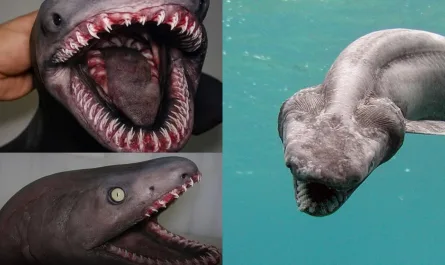On January 26, 2025, a rare and chilling encounter unfolded off the coast of Tenerife in the Canary Islands, when marine biologists from the NGO Condrik Tenerife spotted a living black seadevil (Melanocetus johnsonii), a deep-sea anglerfish, near the ocean’s surface in broad daylight. Known for its grotesque appearance—sharp, needle-like teeth, a gaping jaw, and a bioluminescent lure dangling like a sinister beacon—this tiny predator, with females reaching 18 cm (7 inches) and males a mere 3 cm (1.2 inches), is a denizen of the ocean’s darkest depths, typically 200–2,000 meters below. Captured on video by marine photographer David Jara Boguñá, this unprecedented sighting, potentially the first of a live adult black seadevil at the surface, offers a haunting glimpse into the mysterious world of deep-sea predators and underscores how little we know about the ocean’s abyss.
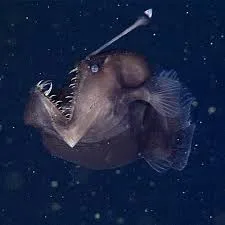
The Creature from the Deep
The black seadevil, aptly named from the Greek melanos (black) and cetus (sea monster), is a nightmare of evolution. Females, the larger sex, sport a bulbous body, jet-black skin, and a dorsal lure (illicium) tipped with a glowing esca powered by bioluminescent bacteria. This lure attracts prey—small fish and crustaceans—in the pitch-black depths, where their distensible stomachs allow them to swallow meals larger than themselves. Males, tiny and parasitic, lack lures and fuse to females in a bizarre reproductive strategy, becoming little more than sperm donors. The Tenerife specimen, spotted 2 km off Playa San Juan, was likely female, identified by its lure, and appeared in poor condition, surviving only a few hours after observation.
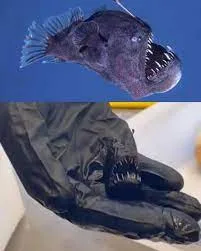
This sighting, documented by marine biologist Laia Valor during a shark research expedition, stunned experts. Black seadevils are rarely seen alive, with prior footage limited to deep-sea submersibles, like Bruce Robison’s 2014 Monterey Bay recording at 600 meters. Its appearance at the surface, possibly due to illness, upwelling currents, or predator escape, defies its adaptation to extreme pressures, as noted by fish biologist Kory Evans, who initially mistook the footage for AI-generated imagery.
A Rare Encounter
The event, captured in vivid video and shared widely online, sparked fascination and debate. The fish, swimming vertically in a dreamlike ascent, was filmed by David Jara Boguñá, who described it as a “legendary” moment, recalling childhood wonder at deep-sea creatures. Social media buzzed with misconceptions about its size—some estimated it at 2 meters, though females rarely exceed 18 cm. The specimen, preserved at the Museum of Nature and Archaeology in Santa Cruz de Tenerife, offers scientists a chance to study a creature rarely accessible, shedding light on deep-sea biology and environmental changes.
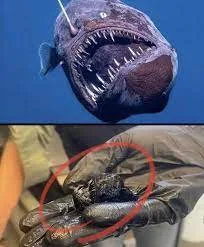
This was no ordinary sighting. Only one other live black seadevil has been filmed, in 2014, making this potentially the first recorded surface observation of an adult in daylight. The ocean’s mesopelagic and bathypelagic zones, where sunlight fades and pressure exceeds 5,850 pounds per square inch, are alien worlds, and this event highlights their mysteries.
Context and Significance
The black seadevil’s appearance parallels other enigmatic relics, like the spearhead in bone or the Tasmanian tiger’s rock art, revealing humanity’s ongoing quest to understand the unknown. Its bioluminescent lure, a natural marvel, mirrors the ingenuity of the Dahomey Amazons’ cornrow maps or the Jadeite Cabbage’s artistry, showing how nature and culture craft solutions for survival. The sighting, near Tenerife’s vibrant marine ecosystems, underscores the ocean’s role as Earth’s largest habitat, producing 50–80% of our oxygen via phytoplankton, as noted in prior discussions.

Yet, it also raises concerns. Climate-driven changes, like warming oceans or altered currents, may be pushing deep-sea creatures to the surface, signaling ecological shifts. The specimen’s poor health suggests stress, possibly from environmental factors, urging further study.
Lessons for Today
This discovery, like the Lamassu’s protective gaze or Irfan Habib’s historical rigor, offers lessons:
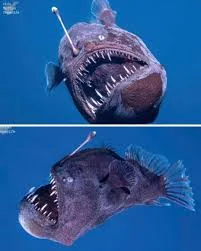
Exploring the Unknown: The black seadevil’s rarity inspires curiosity about uncharted realms, encouraging scientific exploration of oceans and beyond.

Environmental Urgency: Its surface appearance may signal ecological distress, urging action to protect marine habitats, akin to preserving HIMI’s ecosystems.

Nature’s Ingenuity: The fish’s bioluminescent lure reflects adaptive brilliance, inspiring biomimetic technologies, from lighting to medical imaging.
A Window into the Abyss

The black seadevil sighting off Tenerife, with its grotesque beauty and haunting ascent, is a rare portal to the ocean’s depths. Like the Jadeite Cabbage or Baltermants’ frost-napping babies, it captures a moment of wonder and mystery, reminding us of the ocean’s vast unknowns. This tiny terror, glowing in the daylight, screams of a world we’re only beginning to understand, urging us to dive deeper into its dark, untamed heart.



